Welfare Framework for Samantha: An Aboriginal Woman Case Study
VerifiedAdded on 2023/06/09
|7
|2222
|172
Case Study
AI Summary
This case study formulates a welfare system for Samantha, an Aboriginal single mother facing unemployment, inadequate housing, and domestic abuse. The analysis identifies key welfare service domains, including material living conditions, personal safety, and community engagement. The proposed framework emphasizes housing security through Housing Management Agreements, educational opportunities via the Aboriginal Education Policy, and autonomy by empowering Samantha to participate in decisions affecting her and her child. A holistic approach integrates Aboriginal worldviews, aiming to eliminate isolation, strengthen cultural identity, and ensure access to culturally appropriate services. Principles of accountability, access, partnership, and cultural safety guide the framework, which also focuses on educating Samantha about reporting abuse and relocating her to a supportive community. The ultimate goal is to enhance Samantha's overall health and wellbeing by addressing her economic position, housing security, educational attainment, and personal safety.
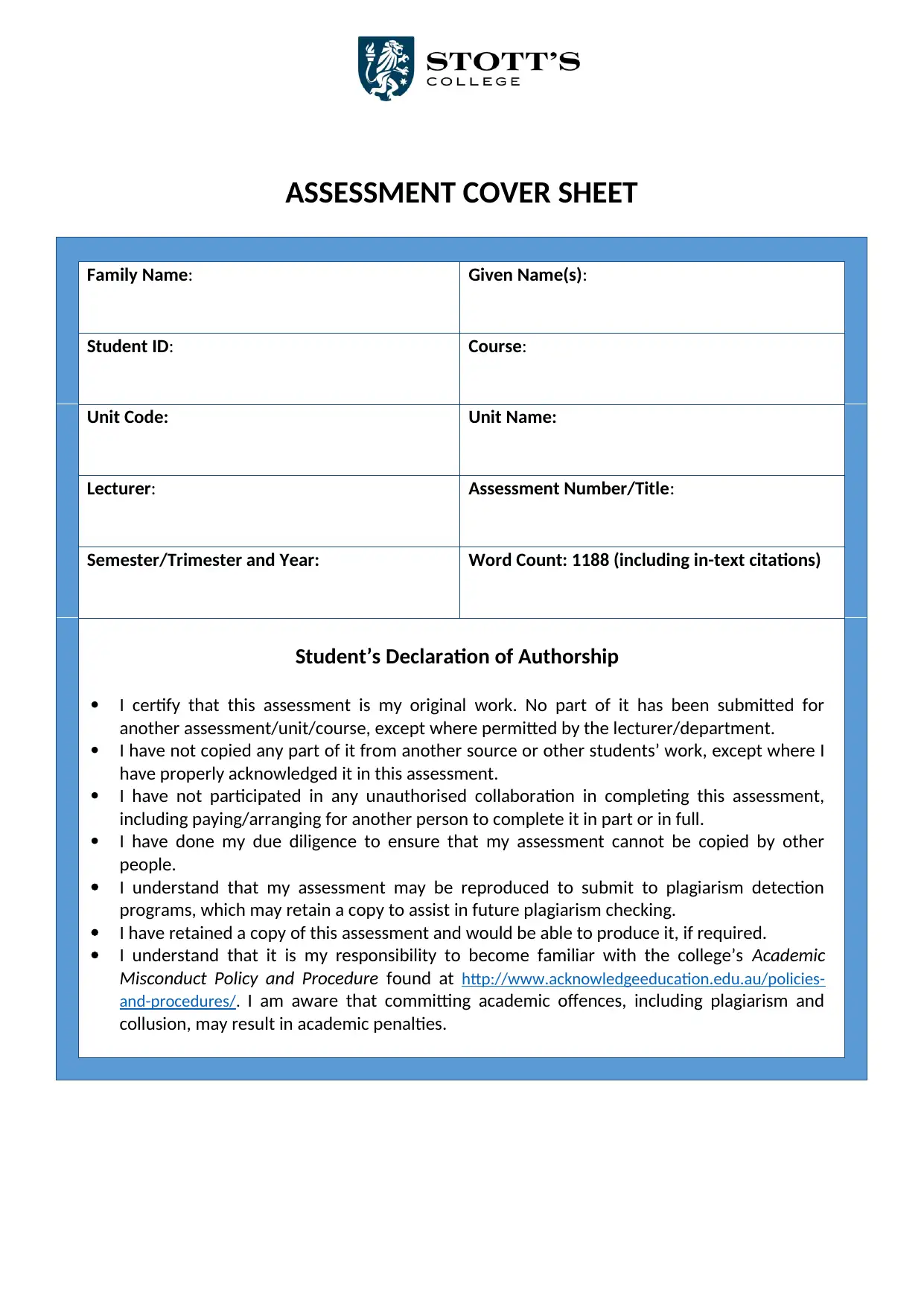
ASSESSMENT COVER SHEET
Family Name: Given Name(s):
Student ID: Course:
Unit Code: Unit Name:
Lecturer: Assessment Number/Title:
Semester/Trimester and Year: Word Count: 1188 (including in-text citations)
Student’s Declaration of Authorship
I certify that this assessment is my original work. No part of it has been submitted for
another assessment/unit/course, except where permitted by the lecturer/department.
I have not copied any part of it from another source or other students’ work, except where I
have properly acknowledged it in this assessment.
I have not participated in any unauthorised collaboration in completing this assessment,
including paying/arranging for another person to complete it in part or in full.
I have done my due diligence to ensure that my assessment cannot be copied by other
people.
I understand that my assessment may be reproduced to submit to plagiarism detection
programs, which may retain a copy to assist in future plagiarism checking.
I have retained a copy of this assessment and would be able to produce it, if required.
I understand that it is my responsibility to become familiar with the college’s Academic
Misconduct Policy and Procedure found at http://www.acknowledgeeducation.edu.au/policies-
and-procedures/. I am aware that committing academic offences, including plagiarism and
collusion, may result in academic penalties.
Family Name: Given Name(s):
Student ID: Course:
Unit Code: Unit Name:
Lecturer: Assessment Number/Title:
Semester/Trimester and Year: Word Count: 1188 (including in-text citations)
Student’s Declaration of Authorship
I certify that this assessment is my original work. No part of it has been submitted for
another assessment/unit/course, except where permitted by the lecturer/department.
I have not copied any part of it from another source or other students’ work, except where I
have properly acknowledged it in this assessment.
I have not participated in any unauthorised collaboration in completing this assessment,
including paying/arranging for another person to complete it in part or in full.
I have done my due diligence to ensure that my assessment cannot be copied by other
people.
I understand that my assessment may be reproduced to submit to plagiarism detection
programs, which may retain a copy to assist in future plagiarism checking.
I have retained a copy of this assessment and would be able to produce it, if required.
I understand that it is my responsibility to become familiar with the college’s Academic
Misconduct Policy and Procedure found at http://www.acknowledgeeducation.edu.au/policies-
and-procedures/. I am aware that committing academic offences, including plagiarism and
collusion, may result in academic penalties.
Paraphrase This Document
Need a fresh take? Get an instant paraphrase of this document with our AI Paraphraser
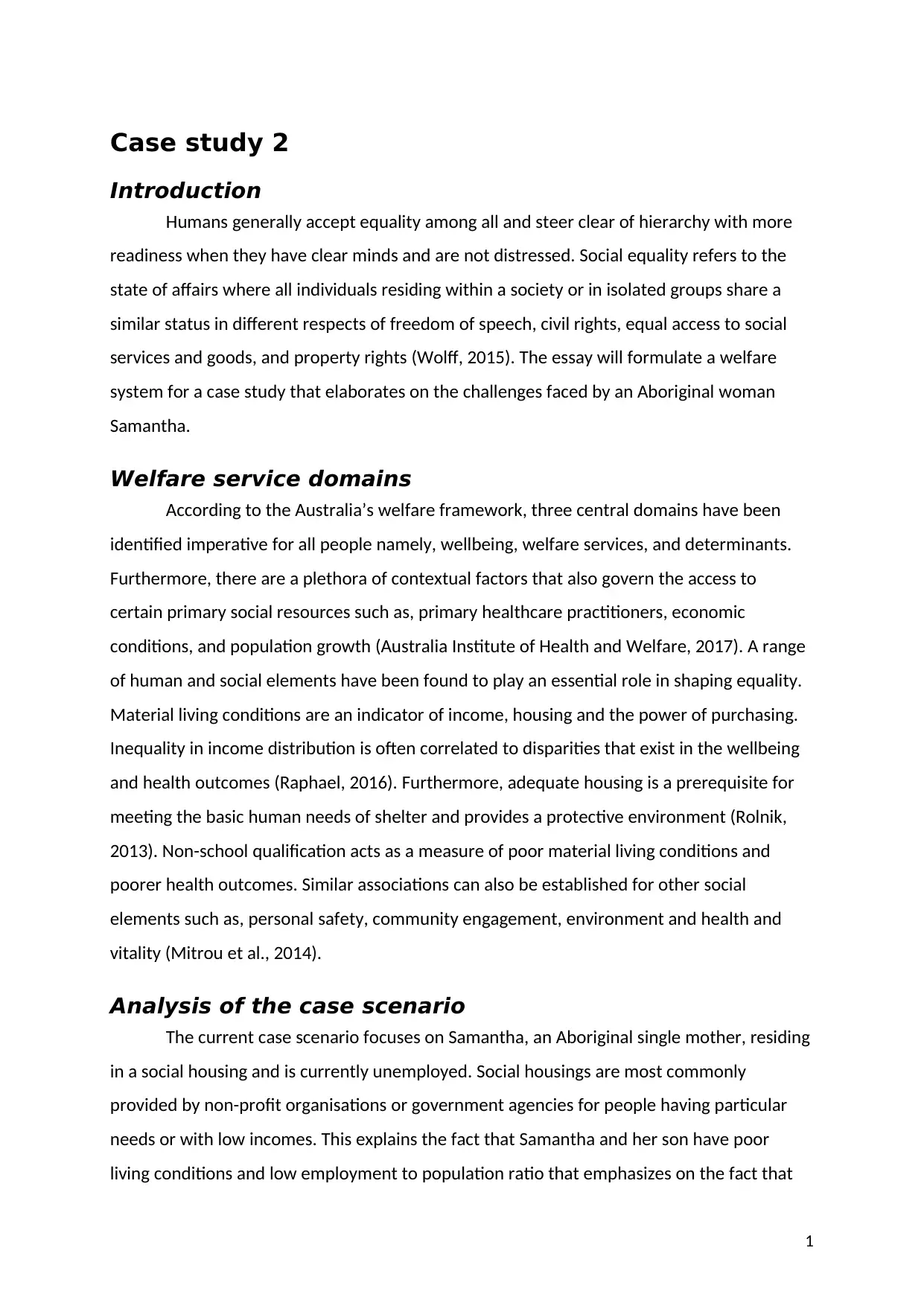
Case study 2
Introduction
Humans generally accept equality among all and steer clear of hierarchy with more
readiness when they have clear minds and are not distressed. Social equality refers to the
state of affairs where all individuals residing within a society or in isolated groups share a
similar status in different respects of freedom of speech, civil rights, equal access to social
services and goods, and property rights (Wolff, 2015). The essay will formulate a welfare
system for a case study that elaborates on the challenges faced by an Aboriginal woman
Samantha.
Welfare service domains
According to the Australia’s welfare framework, three central domains have been
identified imperative for all people namely, wellbeing, welfare services, and determinants.
Furthermore, there are a plethora of contextual factors that also govern the access to
certain primary social resources such as, primary healthcare practitioners, economic
conditions, and population growth (Australia Institute of Health and Welfare, 2017). A range
of human and social elements have been found to play an essential role in shaping equality.
Material living conditions are an indicator of income, housing and the power of purchasing.
Inequality in income distribution is often correlated to disparities that exist in the wellbeing
and health outcomes (Raphael, 2016). Furthermore, adequate housing is a prerequisite for
meeting the basic human needs of shelter and provides a protective environment (Rolnik,
2013). Non-school qualification acts as a measure of poor material living conditions and
poorer health outcomes. Similar associations can also be established for other social
elements such as, personal safety, community engagement, environment and health and
vitality (Mitrou et al., 2014).
Analysis of the case scenario
The current case scenario focuses on Samantha, an Aboriginal single mother, residing
in a social housing and is currently unemployed. Social housings are most commonly
provided by non-profit organisations or government agencies for people having particular
needs or with low incomes. This explains the fact that Samantha and her son have poor
living conditions and low employment to population ratio that emphasizes on the fact that
1
Introduction
Humans generally accept equality among all and steer clear of hierarchy with more
readiness when they have clear minds and are not distressed. Social equality refers to the
state of affairs where all individuals residing within a society or in isolated groups share a
similar status in different respects of freedom of speech, civil rights, equal access to social
services and goods, and property rights (Wolff, 2015). The essay will formulate a welfare
system for a case study that elaborates on the challenges faced by an Aboriginal woman
Samantha.
Welfare service domains
According to the Australia’s welfare framework, three central domains have been
identified imperative for all people namely, wellbeing, welfare services, and determinants.
Furthermore, there are a plethora of contextual factors that also govern the access to
certain primary social resources such as, primary healthcare practitioners, economic
conditions, and population growth (Australia Institute of Health and Welfare, 2017). A range
of human and social elements have been found to play an essential role in shaping equality.
Material living conditions are an indicator of income, housing and the power of purchasing.
Inequality in income distribution is often correlated to disparities that exist in the wellbeing
and health outcomes (Raphael, 2016). Furthermore, adequate housing is a prerequisite for
meeting the basic human needs of shelter and provides a protective environment (Rolnik,
2013). Non-school qualification acts as a measure of poor material living conditions and
poorer health outcomes. Similar associations can also be established for other social
elements such as, personal safety, community engagement, environment and health and
vitality (Mitrou et al., 2014).
Analysis of the case scenario
The current case scenario focuses on Samantha, an Aboriginal single mother, residing
in a social housing and is currently unemployed. Social housings are most commonly
provided by non-profit organisations or government agencies for people having particular
needs or with low incomes. This explains the fact that Samantha and her son have poor
living conditions and low employment to population ratio that emphasizes on the fact that
1
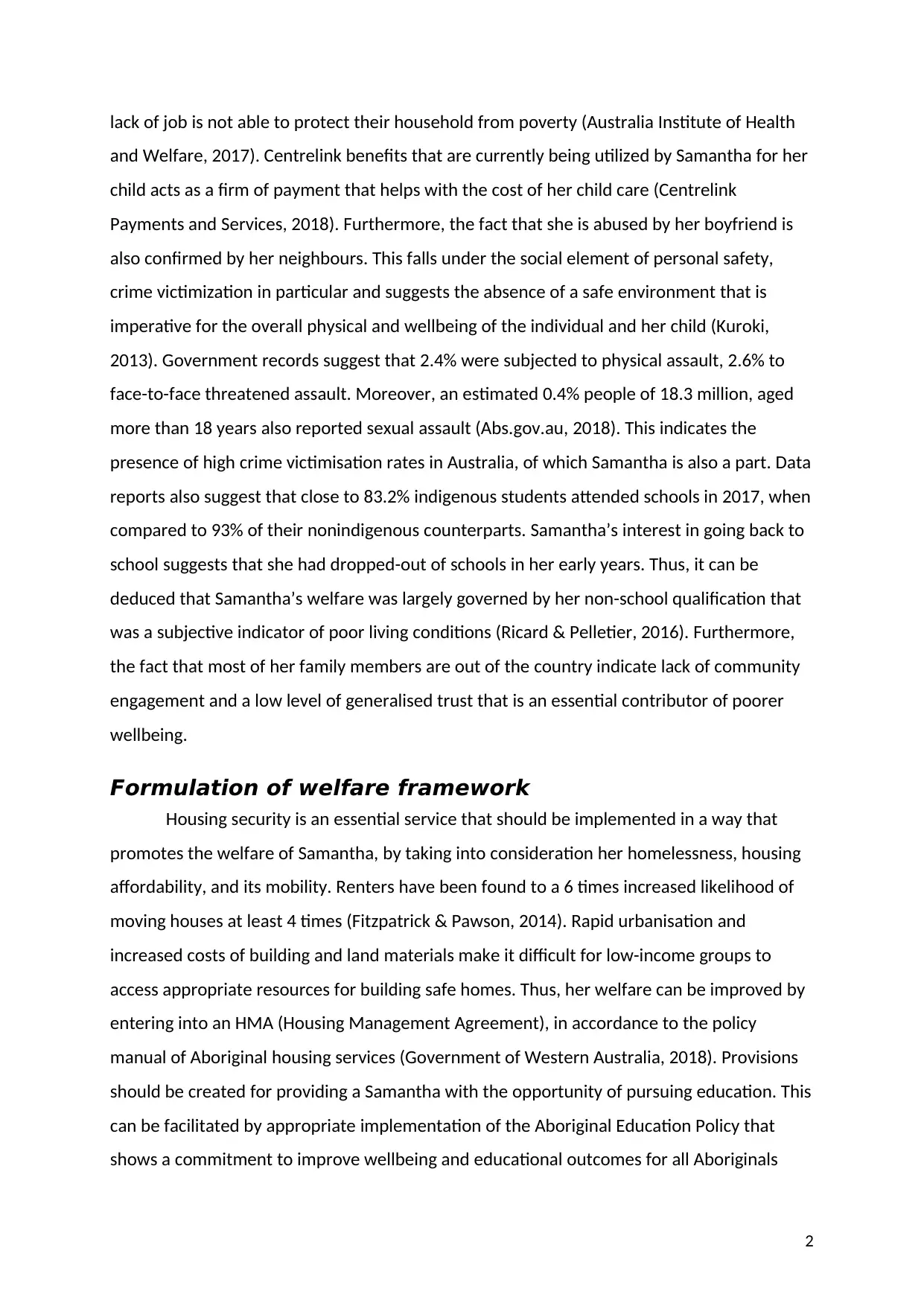
lack of job is not able to protect their household from poverty (Australia Institute of Health
and Welfare, 2017). Centrelink benefits that are currently being utilized by Samantha for her
child acts as a firm of payment that helps with the cost of her child care (Centrelink
Payments and Services, 2018). Furthermore, the fact that she is abused by her boyfriend is
also confirmed by her neighbours. This falls under the social element of personal safety,
crime victimization in particular and suggests the absence of a safe environment that is
imperative for the overall physical and wellbeing of the individual and her child (Kuroki,
2013). Government records suggest that 2.4% were subjected to physical assault, 2.6% to
face-to-face threatened assault. Moreover, an estimated 0.4% people of 18.3 million, aged
more than 18 years also reported sexual assault (Abs.gov.au, 2018). This indicates the
presence of high crime victimisation rates in Australia, of which Samantha is also a part. Data
reports also suggest that close to 83.2% indigenous students attended schools in 2017, when
compared to 93% of their nonindigenous counterparts. Samantha’s interest in going back to
school suggests that she had dropped-out of schools in her early years. Thus, it can be
deduced that Samantha’s welfare was largely governed by her non-school qualification that
was a subjective indicator of poor living conditions (Ricard & Pelletier, 2016). Furthermore,
the fact that most of her family members are out of the country indicate lack of community
engagement and a low level of generalised trust that is an essential contributor of poorer
wellbeing.
Formulation of welfare framework
Housing security is an essential service that should be implemented in a way that
promotes the welfare of Samantha, by taking into consideration her homelessness, housing
affordability, and its mobility. Renters have been found to a 6 times increased likelihood of
moving houses at least 4 times (Fitzpatrick & Pawson, 2014). Rapid urbanisation and
increased costs of building and land materials make it difficult for low-income groups to
access appropriate resources for building safe homes. Thus, her welfare can be improved by
entering into an HMA (Housing Management Agreement), in accordance to the policy
manual of Aboriginal housing services (Government of Western Australia, 2018). Provisions
should be created for providing a Samantha with the opportunity of pursuing education. This
can be facilitated by appropriate implementation of the Aboriginal Education Policy that
shows a commitment to improve wellbeing and educational outcomes for all Aboriginals
2
and Welfare, 2017). Centrelink benefits that are currently being utilized by Samantha for her
child acts as a firm of payment that helps with the cost of her child care (Centrelink
Payments and Services, 2018). Furthermore, the fact that she is abused by her boyfriend is
also confirmed by her neighbours. This falls under the social element of personal safety,
crime victimization in particular and suggests the absence of a safe environment that is
imperative for the overall physical and wellbeing of the individual and her child (Kuroki,
2013). Government records suggest that 2.4% were subjected to physical assault, 2.6% to
face-to-face threatened assault. Moreover, an estimated 0.4% people of 18.3 million, aged
more than 18 years also reported sexual assault (Abs.gov.au, 2018). This indicates the
presence of high crime victimisation rates in Australia, of which Samantha is also a part. Data
reports also suggest that close to 83.2% indigenous students attended schools in 2017, when
compared to 93% of their nonindigenous counterparts. Samantha’s interest in going back to
school suggests that she had dropped-out of schools in her early years. Thus, it can be
deduced that Samantha’s welfare was largely governed by her non-school qualification that
was a subjective indicator of poor living conditions (Ricard & Pelletier, 2016). Furthermore,
the fact that most of her family members are out of the country indicate lack of community
engagement and a low level of generalised trust that is an essential contributor of poorer
wellbeing.
Formulation of welfare framework
Housing security is an essential service that should be implemented in a way that
promotes the welfare of Samantha, by taking into consideration her homelessness, housing
affordability, and its mobility. Renters have been found to a 6 times increased likelihood of
moving houses at least 4 times (Fitzpatrick & Pawson, 2014). Rapid urbanisation and
increased costs of building and land materials make it difficult for low-income groups to
access appropriate resources for building safe homes. Thus, her welfare can be improved by
entering into an HMA (Housing Management Agreement), in accordance to the policy
manual of Aboriginal housing services (Government of Western Australia, 2018). Provisions
should be created for providing a Samantha with the opportunity of pursuing education. This
can be facilitated by appropriate implementation of the Aboriginal Education Policy that
shows a commitment to improve wellbeing and educational outcomes for all Aboriginals
2
⊘ This is a preview!⊘
Do you want full access?
Subscribe today to unlock all pages.

Trusted by 1+ million students worldwide
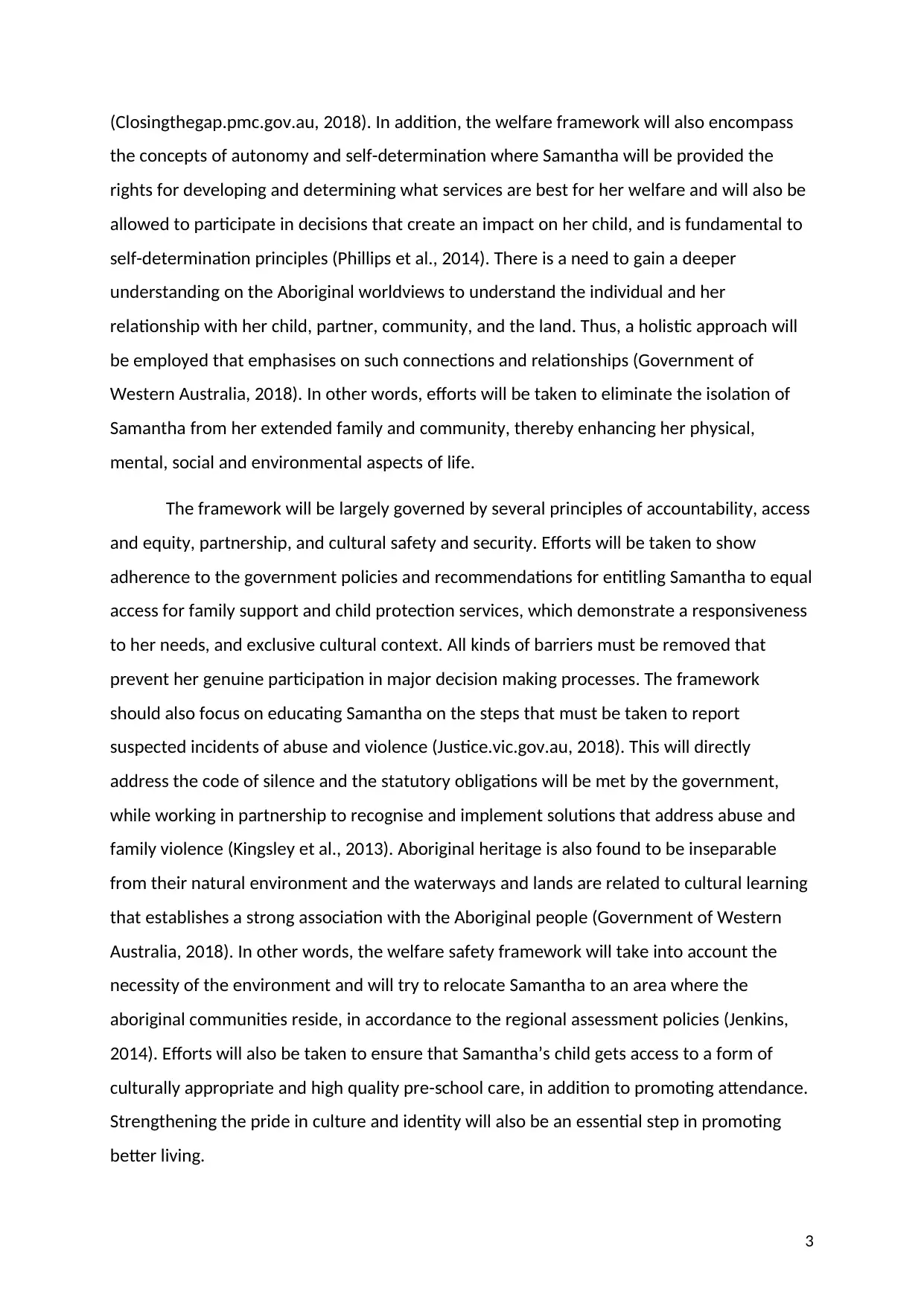
(Closingthegap.pmc.gov.au, 2018). In addition, the welfare framework will also encompass
the concepts of autonomy and self-determination where Samantha will be provided the
rights for developing and determining what services are best for her welfare and will also be
allowed to participate in decisions that create an impact on her child, and is fundamental to
self-determination principles (Phillips et al., 2014). There is a need to gain a deeper
understanding on the Aboriginal worldviews to understand the individual and her
relationship with her child, partner, community, and the land. Thus, a holistic approach will
be employed that emphasises on such connections and relationships (Government of
Western Australia, 2018). In other words, efforts will be taken to eliminate the isolation of
Samantha from her extended family and community, thereby enhancing her physical,
mental, social and environmental aspects of life.
The framework will be largely governed by several principles of accountability, access
and equity, partnership, and cultural safety and security. Efforts will be taken to show
adherence to the government policies and recommendations for entitling Samantha to equal
access for family support and child protection services, which demonstrate a responsiveness
to her needs, and exclusive cultural context. All kinds of barriers must be removed that
prevent her genuine participation in major decision making processes. The framework
should also focus on educating Samantha on the steps that must be taken to report
suspected incidents of abuse and violence (Justice.vic.gov.au, 2018). This will directly
address the code of silence and the statutory obligations will be met by the government,
while working in partnership to recognise and implement solutions that address abuse and
family violence (Kingsley et al., 2013). Aboriginal heritage is also found to be inseparable
from their natural environment and the waterways and lands are related to cultural learning
that establishes a strong association with the Aboriginal people (Government of Western
Australia, 2018). In other words, the welfare safety framework will take into account the
necessity of the environment and will try to relocate Samantha to an area where the
aboriginal communities reside, in accordance to the regional assessment policies (Jenkins,
2014). Efforts will also be taken to ensure that Samantha’s child gets access to a form of
culturally appropriate and high quality pre-school care, in addition to promoting attendance.
Strengthening the pride in culture and identity will also be an essential step in promoting
better living.
3
the concepts of autonomy and self-determination where Samantha will be provided the
rights for developing and determining what services are best for her welfare and will also be
allowed to participate in decisions that create an impact on her child, and is fundamental to
self-determination principles (Phillips et al., 2014). There is a need to gain a deeper
understanding on the Aboriginal worldviews to understand the individual and her
relationship with her child, partner, community, and the land. Thus, a holistic approach will
be employed that emphasises on such connections and relationships (Government of
Western Australia, 2018). In other words, efforts will be taken to eliminate the isolation of
Samantha from her extended family and community, thereby enhancing her physical,
mental, social and environmental aspects of life.
The framework will be largely governed by several principles of accountability, access
and equity, partnership, and cultural safety and security. Efforts will be taken to show
adherence to the government policies and recommendations for entitling Samantha to equal
access for family support and child protection services, which demonstrate a responsiveness
to her needs, and exclusive cultural context. All kinds of barriers must be removed that
prevent her genuine participation in major decision making processes. The framework
should also focus on educating Samantha on the steps that must be taken to report
suspected incidents of abuse and violence (Justice.vic.gov.au, 2018). This will directly
address the code of silence and the statutory obligations will be met by the government,
while working in partnership to recognise and implement solutions that address abuse and
family violence (Kingsley et al., 2013). Aboriginal heritage is also found to be inseparable
from their natural environment and the waterways and lands are related to cultural learning
that establishes a strong association with the Aboriginal people (Government of Western
Australia, 2018). In other words, the welfare safety framework will take into account the
necessity of the environment and will try to relocate Samantha to an area where the
aboriginal communities reside, in accordance to the regional assessment policies (Jenkins,
2014). Efforts will also be taken to ensure that Samantha’s child gets access to a form of
culturally appropriate and high quality pre-school care, in addition to promoting attendance.
Strengthening the pride in culture and identity will also be an essential step in promoting
better living.
3
Paraphrase This Document
Need a fresh take? Get an instant paraphrase of this document with our AI Paraphraser
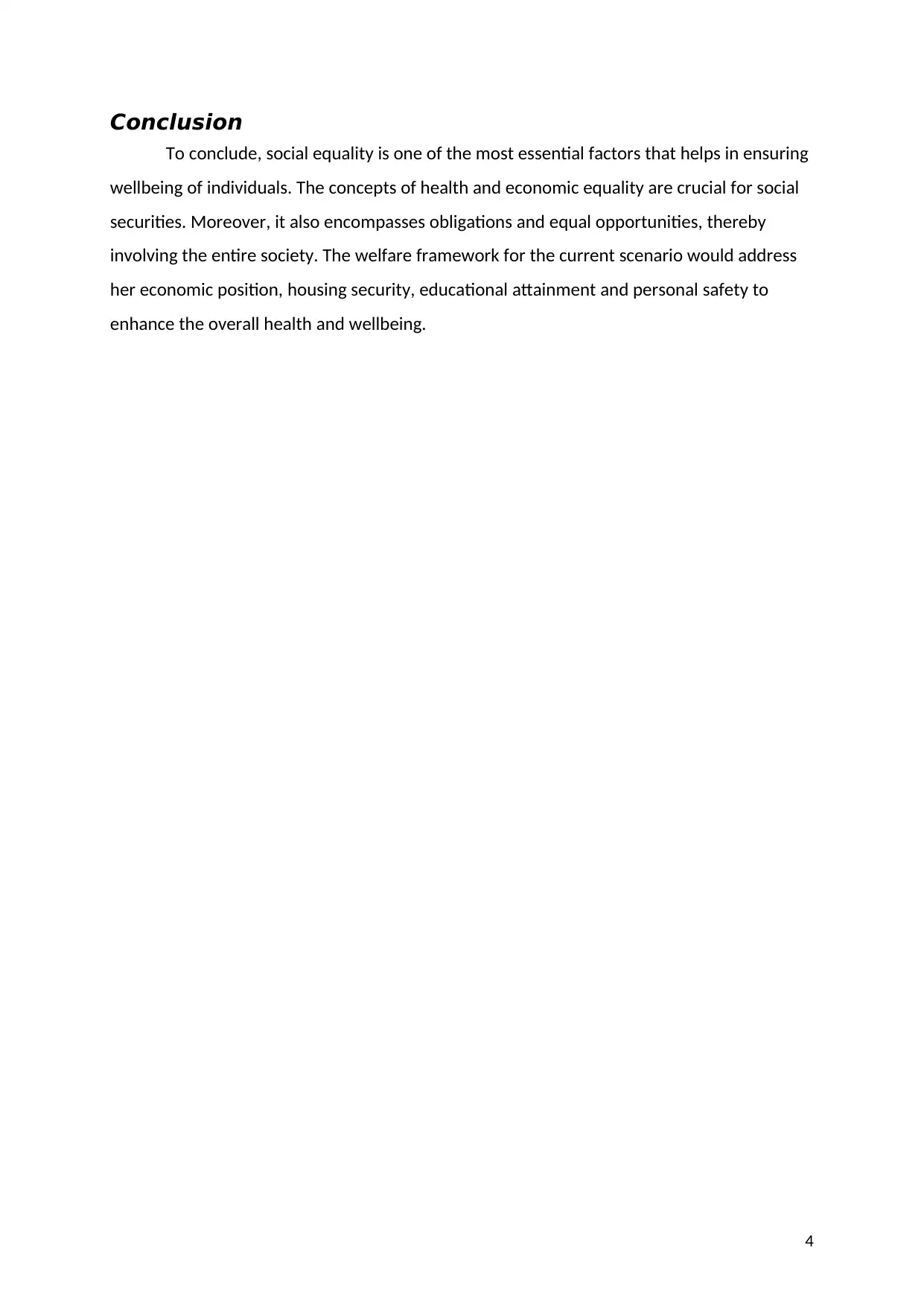
Conclusion
To conclude, social equality is one of the most essential factors that helps in ensuring
wellbeing of individuals. The concepts of health and economic equality are crucial for social
securities. Moreover, it also encompasses obligations and equal opportunities, thereby
involving the entire society. The welfare framework for the current scenario would address
her economic position, housing security, educational attainment and personal safety to
enhance the overall health and wellbeing.
4
To conclude, social equality is one of the most essential factors that helps in ensuring
wellbeing of individuals. The concepts of health and economic equality are crucial for social
securities. Moreover, it also encompasses obligations and equal opportunities, thereby
involving the entire society. The welfare framework for the current scenario would address
her economic position, housing security, educational attainment and personal safety to
enhance the overall health and wellbeing.
4
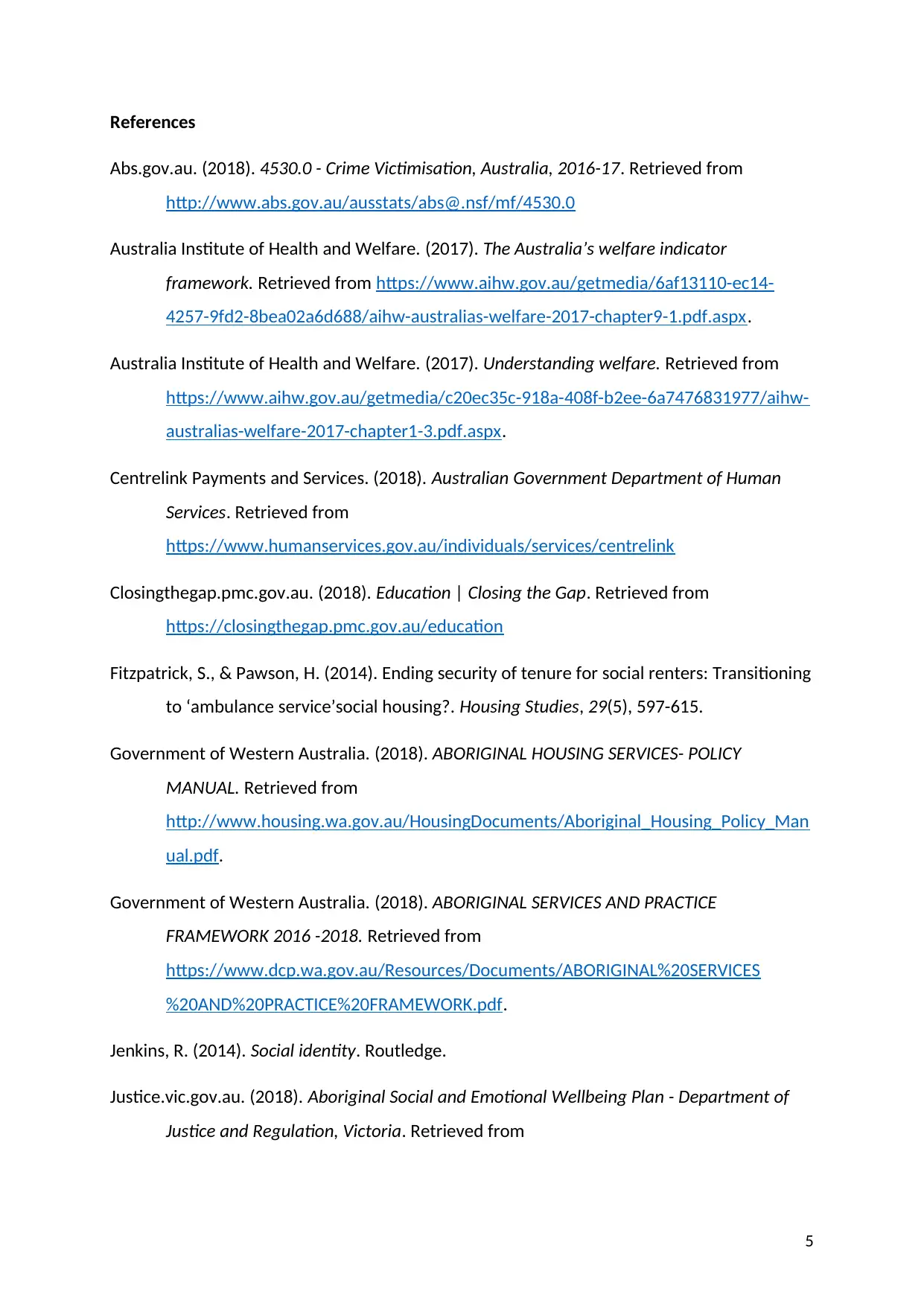
References
Abs.gov.au. (2018). 4530.0 - Crime Victimisation, Australia, 2016-17. Retrieved from
http://www.abs.gov.au/ausstats/abs@.nsf/mf/4530.0
Australia Institute of Health and Welfare. (2017). The Australia’s welfare indicator
framework. Retrieved from https://www.aihw.gov.au/getmedia/6af13110-ec14-
4257-9fd2-8bea02a6d688/aihw-australias-welfare-2017-chapter9-1.pdf.aspx.
Australia Institute of Health and Welfare. (2017). Understanding welfare. Retrieved from
https://www.aihw.gov.au/getmedia/c20ec35c-918a-408f-b2ee-6a7476831977/aihw-
australias-welfare-2017-chapter1-3.pdf.aspx.
Centrelink Payments and Services. (2018). Australian Government Department of Human
Services. Retrieved from
https://www.humanservices.gov.au/individuals/services/centrelink
Closingthegap.pmc.gov.au. (2018). Education | Closing the Gap. Retrieved from
https://closingthegap.pmc.gov.au/education
Fitzpatrick, S., & Pawson, H. (2014). Ending security of tenure for social renters: Transitioning
to ‘ambulance service’social housing?. Housing Studies, 29(5), 597-615.
Government of Western Australia. (2018). ABORIGINAL HOUSING SERVICES- POLICY
MANUAL. Retrieved from
http://www.housing.wa.gov.au/HousingDocuments/Aboriginal_Housing_Policy_Man
ual.pdf.
Government of Western Australia. (2018). ABORIGINAL SERVICES AND PRACTICE
FRAMEWORK 2016 -2018. Retrieved from
https://www.dcp.wa.gov.au/Resources/Documents/ABORIGINAL%20SERVICES
%20AND%20PRACTICE%20FRAMEWORK.pdf.
Jenkins, R. (2014). Social identity. Routledge.
Justice.vic.gov.au. (2018). Aboriginal Social and Emotional Wellbeing Plan - Department of
Justice and Regulation, Victoria. Retrieved from
5
Abs.gov.au. (2018). 4530.0 - Crime Victimisation, Australia, 2016-17. Retrieved from
http://www.abs.gov.au/ausstats/abs@.nsf/mf/4530.0
Australia Institute of Health and Welfare. (2017). The Australia’s welfare indicator
framework. Retrieved from https://www.aihw.gov.au/getmedia/6af13110-ec14-
4257-9fd2-8bea02a6d688/aihw-australias-welfare-2017-chapter9-1.pdf.aspx.
Australia Institute of Health and Welfare. (2017). Understanding welfare. Retrieved from
https://www.aihw.gov.au/getmedia/c20ec35c-918a-408f-b2ee-6a7476831977/aihw-
australias-welfare-2017-chapter1-3.pdf.aspx.
Centrelink Payments and Services. (2018). Australian Government Department of Human
Services. Retrieved from
https://www.humanservices.gov.au/individuals/services/centrelink
Closingthegap.pmc.gov.au. (2018). Education | Closing the Gap. Retrieved from
https://closingthegap.pmc.gov.au/education
Fitzpatrick, S., & Pawson, H. (2014). Ending security of tenure for social renters: Transitioning
to ‘ambulance service’social housing?. Housing Studies, 29(5), 597-615.
Government of Western Australia. (2018). ABORIGINAL HOUSING SERVICES- POLICY
MANUAL. Retrieved from
http://www.housing.wa.gov.au/HousingDocuments/Aboriginal_Housing_Policy_Man
ual.pdf.
Government of Western Australia. (2018). ABORIGINAL SERVICES AND PRACTICE
FRAMEWORK 2016 -2018. Retrieved from
https://www.dcp.wa.gov.au/Resources/Documents/ABORIGINAL%20SERVICES
%20AND%20PRACTICE%20FRAMEWORK.pdf.
Jenkins, R. (2014). Social identity. Routledge.
Justice.vic.gov.au. (2018). Aboriginal Social and Emotional Wellbeing Plan - Department of
Justice and Regulation, Victoria. Retrieved from
5
⊘ This is a preview!⊘
Do you want full access?
Subscribe today to unlock all pages.

Trusted by 1+ million students worldwide
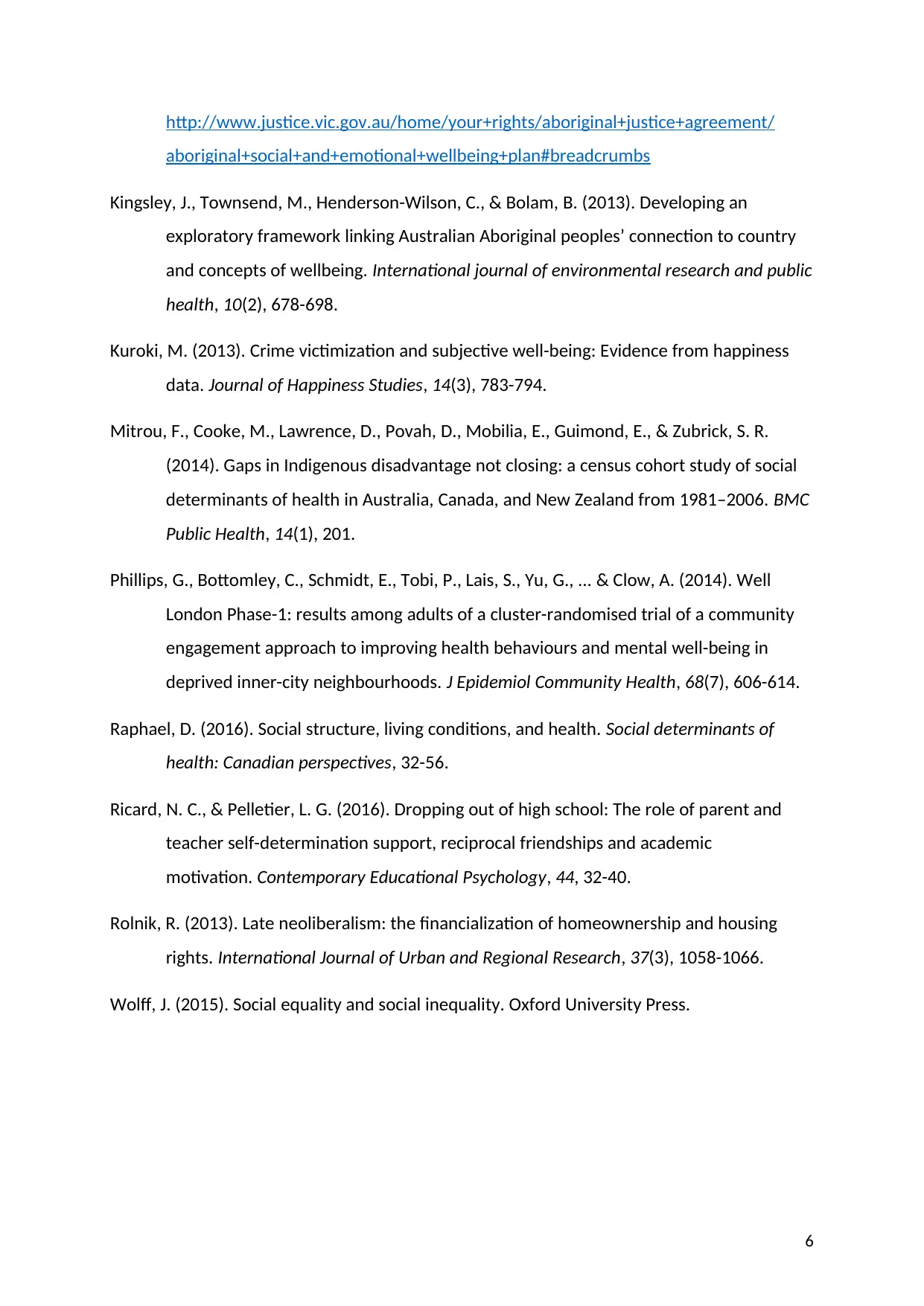
http://www.justice.vic.gov.au/home/your+rights/aboriginal+justice+agreement/
aboriginal+social+and+emotional+wellbeing+plan#breadcrumbs
Kingsley, J., Townsend, M., Henderson-Wilson, C., & Bolam, B. (2013). Developing an
exploratory framework linking Australian Aboriginal peoples’ connection to country
and concepts of wellbeing. International journal of environmental research and public
health, 10(2), 678-698.
Kuroki, M. (2013). Crime victimization and subjective well-being: Evidence from happiness
data. Journal of Happiness Studies, 14(3), 783-794.
Mitrou, F., Cooke, M., Lawrence, D., Povah, D., Mobilia, E., Guimond, E., & Zubrick, S. R.
(2014). Gaps in Indigenous disadvantage not closing: a census cohort study of social
determinants of health in Australia, Canada, and New Zealand from 1981–2006. BMC
Public Health, 14(1), 201.
Phillips, G., Bottomley, C., Schmidt, E., Tobi, P., Lais, S., Yu, G., ... & Clow, A. (2014). Well
London Phase-1: results among adults of a cluster-randomised trial of a community
engagement approach to improving health behaviours and mental well-being in
deprived inner-city neighbourhoods. J Epidemiol Community Health, 68(7), 606-614.
Raphael, D. (2016). Social structure, living conditions, and health. Social determinants of
health: Canadian perspectives, 32-56.
Ricard, N. C., & Pelletier, L. G. (2016). Dropping out of high school: The role of parent and
teacher self-determination support, reciprocal friendships and academic
motivation. Contemporary Educational Psychology, 44, 32-40.
Rolnik, R. (2013). Late neoliberalism: the financialization of homeownership and housing
rights. International Journal of Urban and Regional Research, 37(3), 1058-1066.
Wolff, J. (2015). Social equality and social inequality. Oxford University Press.
6
aboriginal+social+and+emotional+wellbeing+plan#breadcrumbs
Kingsley, J., Townsend, M., Henderson-Wilson, C., & Bolam, B. (2013). Developing an
exploratory framework linking Australian Aboriginal peoples’ connection to country
and concepts of wellbeing. International journal of environmental research and public
health, 10(2), 678-698.
Kuroki, M. (2013). Crime victimization and subjective well-being: Evidence from happiness
data. Journal of Happiness Studies, 14(3), 783-794.
Mitrou, F., Cooke, M., Lawrence, D., Povah, D., Mobilia, E., Guimond, E., & Zubrick, S. R.
(2014). Gaps in Indigenous disadvantage not closing: a census cohort study of social
determinants of health in Australia, Canada, and New Zealand from 1981–2006. BMC
Public Health, 14(1), 201.
Phillips, G., Bottomley, C., Schmidt, E., Tobi, P., Lais, S., Yu, G., ... & Clow, A. (2014). Well
London Phase-1: results among adults of a cluster-randomised trial of a community
engagement approach to improving health behaviours and mental well-being in
deprived inner-city neighbourhoods. J Epidemiol Community Health, 68(7), 606-614.
Raphael, D. (2016). Social structure, living conditions, and health. Social determinants of
health: Canadian perspectives, 32-56.
Ricard, N. C., & Pelletier, L. G. (2016). Dropping out of high school: The role of parent and
teacher self-determination support, reciprocal friendships and academic
motivation. Contemporary Educational Psychology, 44, 32-40.
Rolnik, R. (2013). Late neoliberalism: the financialization of homeownership and housing
rights. International Journal of Urban and Regional Research, 37(3), 1058-1066.
Wolff, J. (2015). Social equality and social inequality. Oxford University Press.
6
1 out of 7
Related Documents
Your All-in-One AI-Powered Toolkit for Academic Success.
+13062052269
info@desklib.com
Available 24*7 on WhatsApp / Email
![[object Object]](/_next/static/media/star-bottom.7253800d.svg)
Unlock your academic potential
Copyright © 2020–2025 A2Z Services. All Rights Reserved. Developed and managed by ZUCOL.





